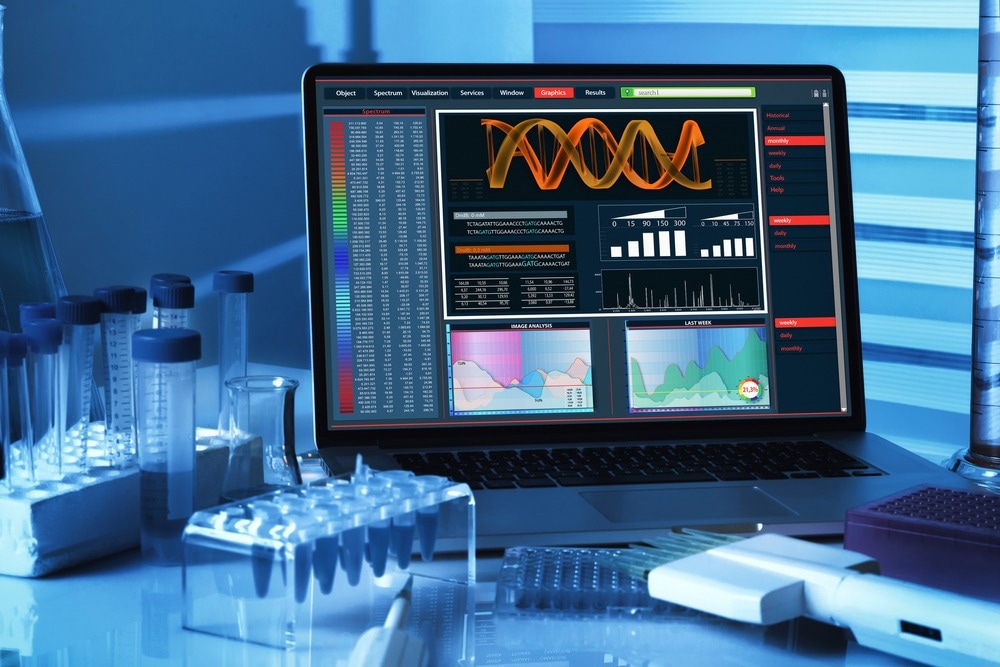A genome-wide association study (GWAS) is a research method that identifies genomic variants associated with particular traits and diseases in a population. This article will discuss GWAS and its application within drug discovery, future challenges, and some specific examples.

Image Credit: angellodeco/Shutterstock.com
What is GWAS?
A wide variety of diseases have some genetic component, from hereditary diseases such as Huntington’s, disorders of the cellular genome such as cancer, and other common and rarer diseases such as asthma, gout, chronic obstructive pulmonary disease, heart failure, chance of stroke, acute appendicitis, and hypertrophic cardiomyopathy, amongst others.
Gene expression is the result of, firstly, the contents of the genome (genes), their epigenetic presentation, and their downstream expression as mRNA, then proteins. Each stage of gene expression may be a valid drug target in treating disease and may be considered within a GWAS.
Typically, GWAS is focused on finding differences within specific genes at certain loci in the population and is often concerned with small changes such as single nucleotide polymorphisms. Small microassays set up for detecting these differences can be utilized. At the same time, studies intended to capture and interpret all genetic information are subcategorized as whole-exome sequencing (WES) or whole-genome sequencing (WGS) studies.
GWAS usually require large sample sizes to generate significant associations between genetic variation and propensity towards, or probable outcome of, disease. Software is generally employed to trawl through the vast quantities of data required, which may originate from specifically designed GWASs or alternatively from other published papers or databases, such as GenBank.
Typically, a combination of newly collected genetic data is utilized along with large datasets representative of the general or a specific subset of the population, assisting with demographic characterization and acting as a control. Many data sets are generally analyzed in tandem to reduce computing time and generate results in a feasible time frame and are combined later, a procedure termed genome-wide association meta-analysis (GWAMA).
How Have GWASs Contributed to Drug Discovery?
The genome and its downstream products constitute a wide variety of drug targets, and dynamic analysis can indicate disease stage or treatment effectiveness; GWAS is, therefore, intensely exploited in the drug discovery process.
The rate of successful drug development has declined significantly in recent decades compared to those prior. In contrast, the cost and time investments involved in bringing new drug products to market have risen dramatically.
Retrospective reviews of drug development projects have shown that GWASs are more likely to produce efficacious drugs than the general rate, especially where rare genetic variants are the cause of disease. For example, it was found that a non-functioning variant of gene PCSK9 was responsible for hyperlipidaemia in some individuals via GWASs, and led to the development of PCSK9 inhibitors that help to control cholesterol.
Similarly, the interleukin-12/interleukin-23 pathway was implicated in the development of Crohn’s disease by GWAS, supporting subsequent clinical trials for drugs targeting this pathway.
Most phenotypic traits are controlled by numerous genetic differences that individually change the probability of disease little, but causal and non-causal variation may influence risk factors. For example, the risk of coronary heart disease is altered by lipid levels, coagulation factors, hypertension, and a variety of other components, each of which may have multiple genetic contributors.
Interestingly, GWAS investigations have revealed an association between coronary heart disease risk factors and cell properties within the vascular system, such as proliferation, adhesion, the state of the extracellular matrix and inflammation, which are all related to the expression of the endothelial and smooth muscle cell genome, and the immune system.
In a specific example, the ADAMTS7 loci was found to code for a metalloproteinase with thrombospondin motifs 7, and was implicated in atherosclerotic progression via smooth muscle cell migration. In vivo experimentation confirmed the causal role of this mutation, and inhibitory drugs are currently being screened for efficacy.
Anti-inflammatory drug tocilizumab and antibodies targeting CD47 have shown some efficacy in mitigating the effects of this mutation, though by differing mechanisms. The former via inhibition of interleukin-6 and subsequently improved endothelial function, the latter by efferocytosis, the clearance of apoptotic cells by phagocytes.
The Future of GWASs in Drug Discovery
While GWAS studies have successfully indicated genetic pathways that lead to effective drug development in a large and growing number of cases, various factors limit the application of GWASs to drug development studies. Most pressingly, the specific pathway leading to various disease states is not always clear, even despite clear genetic and phenotypic association; as discussed, there is difficulty in pinpointing causal and non-causal influence, particularly when the gene is found in non-coding regions.
Even where candidate genes can be clearly identified, their complete function is not yet necessarily known and must be well understood before effective inhibitors can be developed. Further, epigenetic changes associated with disease onset or progression are often rapid and can be influenced by environmental exposures or inflammatory states, and thus are missed in large-scale population studies hoping to find links between genes and future disease occurrence.
Increased incorporation of data from the “omics”: genomics, epigenomics, proteomics, transcriptomics, metabolomics, and lipodomics; will further clarify the complex pathways involved in genetic expression and its association with disease occurrence and progression, allowing effective drugs to be developed that target specific vulnerabilities within this pathway. In particular, cell-type specific details at the multi-omic level will refine understanding of disease etiology, and, in combination with advanced molecular modeling simulations, could produce a new revolution in drug lead discovery.
Sources
Uffelmann, E., et al. (2021). Genome-wide association studies. Nature Reviews Methods Primers, 1(1). doi.org/10.1038/s43586-021-00056-9
Namba, S., et al. (2022). A practical guideline of genomics-driven drug discovery in the era of global biobank meta-analysis. Cell Genomics, 2. doi.org/10.1016/j.xgen.2022.100190
Shu, L., Blencowe, M. et al. (2018). Translating GWAS Findings to Novel Therapeutic Targets for Coronary Artery Disease. Front. Cardiovasc. Med., 5. doi.org/10.3389/fcvm.2018.00056
Further Reading